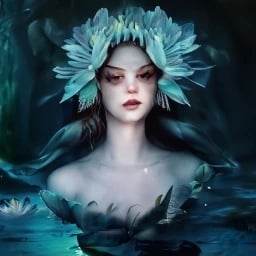Lament Of The Rusalka: A Slavic Tale Of Water And Enchantment
10th May 2023
Categorized Under: Myths and Legends from Around the World
Comments (0)
LAMENT OF THE RUSALKA: A SLAVIC TALE OF WATER AND ENCHANTMENT
The legend of Rusalka originated in Eastern Slavic folklore, particularly in regions such as Russia, Ukraine, and Belarus. The legend likely has ancient roots, dating back to pre-Christian pagan beliefs and practices that were later absorbed into Slavic mythology.
Rusalka was originally associated with nature, particularly bodies of water such as rivers, lakes, and ponds. The term “Rusalka” is derived from the Old Slavic word “rusa,” which means “water” or “dew,” emphasizing the connection between this mythological figure and water.
The exact origins and timeframe of the Rusalka legend are difficult to determine, as folklore tends to evolve through oral traditions and cultural exchanges. However, references to water spirits resembling Rusalkas can be found in early Slavic folktales and songs, and the concept of the rusalka as a vengeful or alluring spirit has been documented in Slavic folklore for centuries.
With the spread of Christianity in Eastern Slavic regions during the medieval period, the legend of Rusalka underwent some changes and was sometimes assimilated into Christian beliefs. For example, Rusalka Week, the period when Rusalkas were believed to be most active, coincided with the Christian holiday of Pentecost or Whitsunday, adding a Christian element to the legend.
Today, the legend of Rusalka continues to be a part of Slavic folklore and cultural heritage, and it has been passed down through generations in various forms of art, literature, and customs.
The legend says that there was a young maiden who lived in a small village near a river in Russia. She was known for her beauty and grace and loved spending time near the water, singing, and dancing. One day, while she was bathing in the river, she drowned under mysterious circumstances. Some versions of the story depict her as a tragic accident victim, while others suggest foul play.
After her death, the maiden’s spirit transformed into a rusalka, a water nymph or spirit. As a rusalka, she became a supernatural being with powers over water and a haunting, otherworldly appearance. Rusalka was neither alive nor dead, and she was bound to the waters where she perished.
As a Rusalka, the maiden’s nature changed. She was now both alluring and dangerous, often depicted as a seductive and vengeful spirit. She would appear to men who ventured near the water, using her enchanting beauty and voice to lure them into the depths, where they would drown. In some versions, Rusalka would also seek revenge on men for their misdeeds towards women or for causing her death.
Rusalka was believed to be most active during the nights of Rusalka Week, which typically fell in early June in Slavic folklore. During this time, it was customary for people to avoid going near bodies of water, lest they fall victim to the rusalka’s allure.
In some variations of the story, Rusalka was not always malevolent. She was also portrayed as a melancholic and tragic figure, longing for her lost life and love. She would sometimes appear as a weeping, mournful spirit, or sing haunting songs that expressed her sorrow and longing.
There are also tales of Rusalkas who were capable of changing their demeanor, appearing friendly and benevolent to those who treated them with kindness or respect. In such stories, Rusalka may offer guidance or assistance to those in need, or even fall in love with a mortal and seek a way to break free from her watery existence.
PERSONALITY:
In Slavic folklore, Rusalka is often depicted with a complex and multi-faceted personality. As a water nymph, her personality traits can vary depending on different interpretations and regional variations of the legend. Here are some common personality traits associated with Rusalka:
-
Enigmatic: Rusalka is often portrayed as mysterious and elusive, shrouded in an air of enchantment. She is known to appear suddenly, luring unsuspecting men with her alluring beauty and captivating voice. Her intentions and desires are not always clear, adding to her enigmatic persona.
-
Seductive: Rusalka is often portrayed as a seductress, using her beauty, voice, and enchanting demeanor to allure men into the water. She is believed to possess a mesmerizing charm that can bewitch those who come near her. However, her seductive nature is also often portrayed as dangerous, as it can lead to the demise of those who succumb to her charms.
-
Tragic: Rusalka is also depicted as a tragic figure, longing for the warmth of the sun and human companionship. Her transformation into a rusalka is often portrayed as a curse or punishment, and she is sometimes shown as mourning her lost life and love. Her melancholic nature and yearning for what she has lost evoke feelings of sorrow and sympathy.
-
Vengeful: In some versions of the legend, Rusalka is portrayed as vengeful towards humans, particularly men. It is believed that she seeks revenge for her untimely death or past wrongs inflicted upon her. She may be depicted as a vengeful spirit, seeking retribution for her fate and luring men to their doom as a form of revenge.
-
Nature-connected: Rusalka is also often associated with the forces of nature, particularly water. She is portrayed as being deeply connected to rivers, lakes, and ponds.
PHYSICAL APPEARANCE:
The physical appearance of Rusalka, as depicted in Slavic folklore, can vary depending on different interpretations and regional variations of the legend. However, some common descriptions of Rusalka’s physical appearance include:
-
Beauty: Rusalka is often described as incredibly beautiful, with an otherworldly allure that can captivate the hearts of those who behold her. She is believed to have stunning features, such as radiant skin, captivating eyes, and lustrous hair that may be depicted as flowing or floating in the n water.
-
Ethereal or ghostly: As a water nymph or ghostly spirit, Rusalka is often portrayed as having a translucent or ghostly appearance. She may be depicted as a shimmering figure, with a diaphanous or watery quality to her form, giving her an otherworldly and ethereal appearance.
-
Nude or partially clothed: In some versions of the legend, Rusalka is depicted as being unclothed or partially clothed, with her beauty and purity emphasized through her nakedness. She may be portrayed wearing flowing robes, wreaths of water lilies, or other adornments associated with water and nature.
-
Serene or mournful: Rusalka’s expression and demeanor can vary, depending on the interpretation of the legend. She may be portrayed as serene and peaceful, embodying the tranquility of water, or she may be depicted as mournful, reflecting her tragic fate and longing for her lost life.
-
Shapeshifting abilities: Rusalka is often believed to have the ability to shapeshift, and she may appear in different forms depending on the situation or her mood. She may transform into a beautiful maiden, a fish-like creature, or take on a more monstrous or grotesque appearance, depending on the story or depiction.
HERE ARE SOME LESSER-KNOWN FACTS ABOUT HER:
-
Varying Nature: In Slavic folklore, Rusalka’s character can vary widely depending on different regions and interpretations. While she is often depicted as a water nymph or mermaid, she can also be seen as a ghostly spirit, a demon, or a fairy-like creature. In some stories, she is portrayed as a malevolent being, luring humans to their deaths, while in others, she is depicted as a more benevolent figure.
-
Seasonal Creatures: Rusalki are often associated with the spring and summer seasons in Slavic folklore. They are believed to emerge during the time of year when nature is at its peak, and they are often associated with the blooming of flowers, the fertility of water sources, and the warmth of the sun.
-
Rituals and Taboos: In some Slavic cultures, there are various rituals and taboos associated with Rusalki. For example, there are beliefs that one should not swim or bathe in certain bodies of water when Rusalki are believed to be active, as they are considered to be dangerous or malevolent during that period. There are also rituals performed to appease Rusalki or protect against their influence, such as leaving offerings at water sources or performing specific rites to ward off their malevolent intentions.
-
Origins in Ancestral Worship: Some scholars believe that the legend of Rusalka may have originated from ancient Slavic traditions of ancestral worship. Rusalki were believed to be the spirits of deceased maidens who died untimely deaths, such as drowning or murder, and they were venerated and propitiated as ancestral guardians of water bodies.
-
The Symbolism of Feminine Nature: Rusalka is often seen as a symbol of feminine nature and the mysteries of water. She embodies the untamed and unpredictable aspects of nature, reflecting the dual nature of water as both life-giving and potentially dangerous. Rusalka’s story is often interpreted as a metaphor for the challenges and complexities of femininity, including themes of desire, sacrifice, and the struggle between the supernatural and human realms.
These lesser-known facts about Rusalka add depth and complexity to her character and highlight the rich cultural and mythological significance associated with this intriguing figure from Slavic folklore.
Additionally, one of the most famous stories involving Rusalka is the opera “Rusalka” composed by Czech composer Antonín Dvo?ák. The opera “Rusalka” is based on the Slavic folklore legend of Rusalka, the water nymph or mermaid, and was first performed in 1901. The libretto, written by Jaroslav Kvapil, tells the story of Rusalka, a water nymph who falls in love with a human prince and longs to become mortal to be with him.
In Dvo?ák’s opera, Rusalka’s story is a tragic tale of unrequited love, longing, and the consequences of crossing between the realms of humans and supernatural beings. Rusalka makes a pact with a witch to become mortal, sacrificing her voice in the process, to be with her beloved prince. However, her dream of human life with her prince turns into a nightmare as she faces rejection and betrayal from the prince and society, ultimately leading to her demise.
The opera “Rusalka” is known for its beautiful music, including the famous aria “Song to the Moon” (M?sí?ku na nebi hlubokém), which is one of the most beloved and well-known pieces from the opera. It has been performed in numerous opera houses around the world and remains a popular and enduring work in the operatic repertoire, showcasing the enduring appeal and fascination with the legend of Rusalka.
Click here to read Kidsinco’s Complete List of Playscripts:
Page 1
Page 2
Page 3
Page 4
Click here to read Kidsinco’s Myths and Legends from Around the World
Please read our Terms of Use
Instagram: @kidsinco
Tags: Rusalka, Russian legend, Slavic folklore



